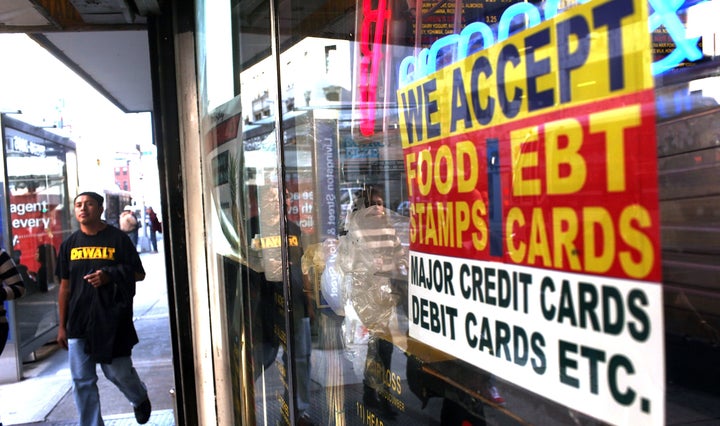
After the GOP’s tax reform bill passed in December 2017, House Speaker Paul Ryan vowed to address benefits reform in 2018, citing it as “how you tackle the debt and the deficit.” The president’s proposed 2018 budget calls for $193 billion in cuts to the Supplemental Nutrition Assistance Program over the next decade, ostensibly to help pay for tax cuts for businesses and the wealthy. All of this is to jump start, Republicans argue, a trickle-down economic effect that will benefit Americans.
This is false political posturing, however, because SNAP (also commonly referred to as the food stamps program) demonstrates the opposite is true. By providing food assistance for our poorest Americans, we experience a demonstrable trickle-up economic effect.
Government data has for decades shown food assistance programs like SNAP do more than just improve nutrition for America’s most vulnerable citizens; they also increase jobs and boost the economy from the bottom up. According to the non-partisan Center on Budget and Policy Priorities, “every $1 increase in SNAP benefits generates about $1.70 in economic activity.” The U.S. government’s own SNAP information guide reports that “on average, $1 billion of retail food demand by SNAP recipients generates 3,300 farm jobs.” In 2009 alone, SNAP beneficiaries spent $25 billion in benefits at supermarkets, and they spent $3.6 billion at grocery and convenience stores, farmer’s markets and other smaller retailers.
“Our current administration, which claims to be pro-business, keeps threatening cuts to food assistance programs.”
Dr. Joyce Furfero, an economics professor at St. John’s University, used the multiplier effect to explain to me why benefits spending helps the economy. Essentially, when someone is given a dollar, the recipient decides to spend or save that dollar. If the recipient spends it, the next person who it is given to has the same choice. And so on. According to Dr. Furfero, low-income Americans have a “much higher marginal propensity to consume than people at the higher end. You give money to someone at the higher end, they put money in the bank. They save it. You give a dollar to someone at the lower end, they go out and spend it.”
For decades, conservative lawmakers have attempted to sell Americans on the idea of trickle-down economics, arguing the more money businesses and the wealthiest citizens have (which they often receive in the form of tax breaks or subsidies), the more these profits will “trickle down” to the middle and working class in the form of more and better-paying jobs. Yet as Dr. Furfero explained, the data show the multiplier effect is greatest when money is given to those at the lowest end of the income spectrum. Low-income individuals typically spend all of the money they receive (out of necessity) and will sometimes even leverage each dollar for additional spending through the use of credit. Those at the highest end of the spectrum, however, tend to spend only a small percentage of each dollar they receive and save the rest. This means government spending on low-income Americans, whether in the form of SNAP benefits or tax cuts, gets politicians more bang for their buck in terms of economic and employment impact.
If recent research and established economic models aren’t adequate enough for the GOP, they can also turn to history for further proof food assistance programs improve the economy. The first food stamps program was created in the 1930s at the pit of the Great Depression. An agricultural surplus lowered prices (and profits) for farmers, and vast unemployment and other economic factors thrust many Americans into poverty. President Franklin Roosevelt initially suggested helping farmers by encouraging them to destroy their crops and kill livestock to raise prices, but a broad outcry at deliberately throwing out food when so many Americans were going hungry caused the president to change tactics. Instead, Roosevelt initiated the first food stamps program, which bought that agricultural surplus and redistributed it to the neediest Americans.
Businesses and poverty advocates alike applauded this program; not only did it improve nutrition for the most marginalized populations, it also had an immediate positive effect on small businesses, because the poor had more money to spend on other goods. The program ended during World War II as economic conditions for Americans changed for the better, but President Lyndon Johnson re-initiated the program in the 1960s following the success of a pilot program that again showed nutritional gains for low-income families “while strengthening markets for the farmer and immeasurably improving the volume of retail food sales.”
Despite the evidence, December’s tax reform bill once again used trickle-down economics as a justification for lowering corporate tax rates and cited potential economic growth as how the ensuing deficit would be paid for. But even the president acknowledged this money was going to stay in the pockets – or bank accounts, as it were ― of the wealthiest Americans when he reportedly told his Mar-a-Lago friends “you all just got a lot richer” after the bill passed. To further combat SNAP’s well-documented effectiveness, conservatives have subjected the program to a multifront smear campaign, with detractors alleging it is rife with fraud, perpetuates poor eating habits and de-incentivizes working. All of these claims have, of course, been debunked.
“Government spending on low-income Americans, whether in the form of SNAP benefits or tax cuts, gets politicians more bang for their buck.”
SNAP is widely considered to be one of the most effective benefits programs today, with broad economic gains for individuals and businesses alike. However, our current administration, which claims to be pro-business, keeps threatening cuts to food assistance programs. Why? Because if the GOP were to acknowledge the positive effects these programs have had on the overall economy, it would also have to acknowledge the reason why: Trickle-up economics ― providing assistance to our country’s poor ― benefits the economy from the bottom up.
Americans must resist the GOP’s ongoing propaganda about the ills of food assistance programs and educate ourselves on the larger economic factors at play when it comes to programs like SNAP. Only then will we be ready the next time a group of politicians uses these programs as an excuse to cut funding and pad the pockets of their wealthy friends.
Suzanne Cope is the author of Small Batch and an upcoming book on food and political revolution. She is a food studies and writing scholar and teaches at St. John’s University.
